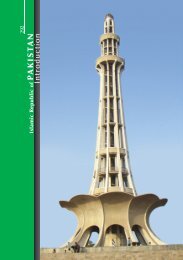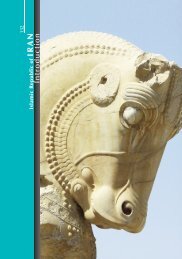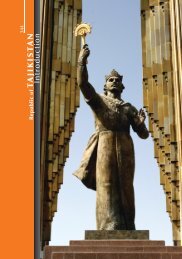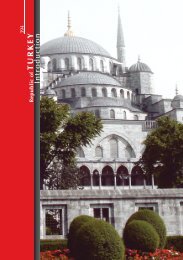ECO-IEST President, Alternative Member to the IPBES Bureau
ECO-IEST President, Alternative Member to the IPBES Bureau
ECO-IEST President, Alternative Member to the IPBES Bureau
Create successful ePaper yourself
Turn your PDF publications into a flip-book with our unique Google optimized e-Paper software.
Water<br />
Technology<br />
depth of <strong>the</strong> aquifer and <strong>the</strong> slope of <strong>the</strong> ground,<br />
Ghanats vary greatly in length; in some <strong>the</strong> conduit<br />
from <strong>the</strong> head well <strong>to</strong> <strong>the</strong> mouth is only a mile or two<br />
long, and at <strong>the</strong> o<strong>the</strong>r extreme one in sou<strong>the</strong>rn Iran is<br />
more than 18 miles long. Commonly <strong>the</strong> length is<br />
between six and 10 miles. The water discharge obtainable<br />
from individual Ghanats also varies widely. For<br />
example, of some 200 Ghanats in <strong>the</strong> Varamin plain,<br />
sou<strong>the</strong>ast of Tehran <strong>the</strong> largest yields 72 gallons per second<br />
and <strong>the</strong> smallest only a quarter of a gallon per second.<br />
Not until <strong>the</strong> Ghanat has been completed and has<br />
operated for some time is it possible <strong>to</strong> determine<br />
whe<strong>the</strong>r it will be a continuous "runner" or a seasonal<br />
source that provides water only in <strong>the</strong> spring or after<br />
heavy rains.<br />
Because <strong>the</strong> initial investment in construction of a<br />
Ghanat is considerable, <strong>the</strong> owner and builders often<br />
resort <strong>to</strong> probing and laborious devices <strong>to</strong> enlarge its<br />
yield. For example, <strong>the</strong>y may extend branches from <strong>the</strong><br />
main conduit <strong>to</strong> reach additional aquifers or excavate<br />
<strong>the</strong> floor of <strong>the</strong> existing conduit in order <strong>to</strong> lower it and<br />
tap water at a deeper level.<br />
A great deal of care is also given <strong>to</strong> <strong>the</strong> maintenance of<br />
<strong>the</strong> Ghanat. The ventilation shafts are shielded at <strong>the</strong><br />
<strong>to</strong>p with crater-like walls of spoil and sometimes with<br />
hoods <strong>to</strong> prevent <strong>the</strong> inflow of damaging s<strong>to</strong>rm waters.<br />
Muqanni are continually kept employed cleaning out<br />
silt that is washed in<strong>to</strong> <strong>the</strong> conduit from <strong>the</strong> aquifer,<br />
clearing up roof cave-ins and making o<strong>the</strong>r repairs.<br />
As is <strong>to</strong> be expected of a system that has existed for<br />
thousands of years and is so important <strong>to</strong> <strong>the</strong> life of <strong>the</strong><br />
nation, <strong>the</strong> building of Ghanats and <strong>the</strong> distribution of<br />
<strong>the</strong> water are ruled by laws and common understandings<br />
that are hallowed by tradition. The builders of a<br />
Ghanat must obtain <strong>the</strong> consent of <strong>the</strong> owners of <strong>the</strong><br />
land it will cross, but permission cannot be refused arbitrarily.<br />
It must be granted if <strong>the</strong> new Ghanat will not<br />
interfere with <strong>the</strong> yield from an existing Ghanat, which<br />
usually means that <strong>the</strong> distance between <strong>the</strong> two must<br />
be several hundred yards, depending on <strong>the</strong> geological<br />
formations involved. When <strong>the</strong> parties cannot agree, <strong>the</strong><br />
matter is decided by <strong>the</strong> courts, which normally appoint<br />
an independent expert <strong>to</strong> resolve <strong>the</strong> technical questions<br />
at issue.<br />
Similarly, <strong>the</strong>re are traditional systems for <strong>the</strong> fair<br />
allocation of water from a Ghanat <strong>to</strong>-<strong>the</strong> users. If<br />
<strong>the</strong> Ghanat is owned by a landowner who<br />
has tenant farmers, he usually appoints a<br />
water bailiff who supervises <strong>the</strong> allotment<br />
of water <strong>to</strong> each tenant in accordance<br />
with <strong>the</strong> size of <strong>the</strong> tenant's farm and <strong>the</strong><br />
nature of <strong>the</strong> crop he is growing. When<br />
<strong>the</strong> peasants <strong>the</strong>mselves<br />
own <strong>the</strong> Ghanat, <strong>the</strong>y<br />
elect a trustworthy water<br />
bailiff who<br />
sees that each farmer receives his just share of <strong>the</strong> water<br />
at <strong>the</strong> proper time - and who receives a free share himself<br />
for his service. The bailiff is guided by an allocation<br />
system that has been fixed for hundreds of years. For<br />
instance, three hamlets in <strong>the</strong> region of Selideh in western<br />
Iran still receive <strong>the</strong> shares that were allotted <strong>to</strong><br />
<strong>the</strong>m in <strong>the</strong> 17th century by <strong>the</strong> civil engineer in <strong>the</strong><br />
reign of Shah Abbas <strong>the</strong> Great.<br />
The hamlets of Dastgerd and Parvar are entitled <strong>to</strong><br />
eight shares apiece and Kar<strong>to</strong>n nine shares and <strong>the</strong>se<br />
allocations are built in<strong>to</strong> <strong>the</strong> outlets from <strong>the</strong> Ghanat distribution<br />
basin: <strong>the</strong> outlets at Dastgerd and Parvar are<br />
eight spans wide and <strong>the</strong> one at Kar<strong>to</strong>n is nine spans<br />
wide.<br />
Whatever <strong>the</strong> future of Iran's Ghanat system may be, it<br />
stands out <strong>to</strong>day as an impressive example of a determined<br />
and hardworking people's achievement. The<br />
22,000 Ghanats in Iran, with <strong>the</strong>ir 170,000 miles of<br />
underground conduits all built by manual labor, deliver<br />
a <strong>to</strong>tal of 19,500 cubic feet of water per second - an<br />
amount equivalent <strong>to</strong> 75 percent of discharge of <strong>the</strong><br />
Euphrates River in<strong>to</strong> <strong>the</strong> Mesopotamian plain. This volume<br />
of water production would be sufficient <strong>to</strong> irrigate<br />
three million acres of arid land for cultivation if it were<br />
used entirely for agriculture. It has made a garden of<br />
what would o<strong>the</strong>rwise have an uninhabitable desert.<br />
There are indications that in early times <strong>the</strong> country had<br />
flourishing vegetation that gradually dried up, partly<br />
because of deforestation and <strong>the</strong> loss of fertile soil by<br />
erosion. The Persian people responded <strong>to</strong> potential disaster<br />
with a farsighted solution that is a classic tribute <strong>to</strong><br />
human resourcefulness.<br />
Conclusion<br />
Ghanat system has a profound influence on <strong>the</strong> lives<br />
of <strong>the</strong> water users. It allows those living in a desert environment<br />
adjacent <strong>to</strong> a mountain watershed <strong>to</strong> create a<br />
large oasis in an o<strong>the</strong>rwise stark environment. The<br />
United Nations and o<strong>the</strong>r organizations are encouraging<br />
<strong>the</strong> revitalization of traditional water harvesting and supply<br />
technologies in arid areas because <strong>the</strong>y feel it is<br />
important for sustainable water utilization.<br />
<strong>ECO</strong> CHRONICLE<br />
41















